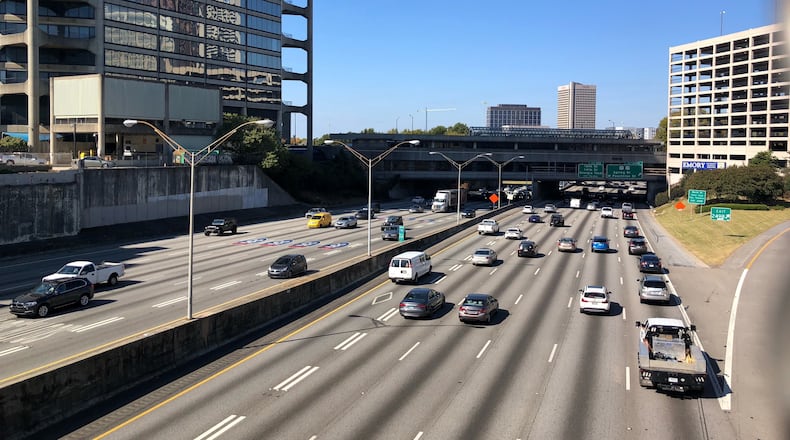The news for Atlanta’s downtown had gotten even more grim in the past few weeks. And that’s saying something.
In mid-February, I took a lonely lunchtime stroll though the once-bustling urban center. There was the mostly empty CNN Center, the South Downtown historic area bought up by German developers who went bust, MARTA’s forlorn Five Points plaza and Underground Atlanta, which is trying yet another reboot.
There had been buzz that staging some World Cup games at Mercedes-Benz Stadium in 2026 might be an impetus to finish some projects, start some others and give the area some badly needed TLC. It would be like tidying up the living room before guests arrive.
But in the weeks since, events painted even a darker portrait of the area. Late last month, RaceTrac closed a station on Piedmont Avenue near Georgia State University after yet another shooting near the business. Days later, Walgreens announced the closing of its store located under the huge Coca Cola sign near Five Points.
The well-lit, usually busy pharmacy/convenience store had stood for eight years as a retail beacon in an increasingly bare environment. The company was set to close the store last year but backed off after some lobbying from Mayor Andre Dickens. However, the Dickens Bump bought it just a year.
And then last weekend, two teenagers and a woman bystander were shot in broad daylight in the Peachtree Street hotel district. More than 30 shell casings littered the pavement. Later that night, a man who had been shot pounded on the window of a police car sitting by the closed RaceTrac.
Credit: Bill Torpy
Credit: Bill Torpy
It seemed downtown just couldn’t get a break.
But then on Tuesday, the U.S. Department of Transportation announced it was ponying up $157.6 million to build The Stitch — which would ultimately be a 14-acre park over the Downtown Connector.
That grant money would be coupled with $40 million of other funds to complete the first of three phases, a 5-acre platform and other improvements over the highway from Peachtree Street west to Courtland Street.
The money is part of the Reconnecting Communities and Neighborhoods fund, focused on “reconnecting” neighborhoods — generally low-income and Black — that were bulldozed decades ago to build these highways.
Senators Raphael Warnock, Jon Ossoff and Congresswoman Nikema Williams all, of course, jumped in to ballyhoo this “transformational” project aimed at communities “historically overlooked” by such federal largesse.
“The Stitch will reclaim a massive part of our city from infrastructure that divided the Black neighborhoods of Buttermilk Bottoms, Bedford Pines, and Sweet Auburn,” said Williams.
Most of those communities have been bulldozed or gentrified, so this project is largely a development play for an area that has largely missed out on major development, unlike Midtown directly to the north. The city has vowed to build affordable housing in the site of the old Civic Center, which is near the proposed Stitch.
A major reason for the federal love is that Georgia is a swing state with Democratic U.S. senators and there’s a presidential election coming. President Joe Biden visited another swing state, Wisconsin, touting a similar grant.
I called A.J. Robinson, who heads of Central Atlanta Progress, a civic organization created to push for development downtown. Before the call, I checked our files so I could recall the substance of our previous chats. I found a running theme in my talks with the man paid to be downtown’s cheerleader.
Here are the print headlines (which sometimes differ from online versions) for my last three stories quoting Robinson:
— (2023) “Can office conversions save downtown?”
— (2022) “Underground might get a chance to resurface”
— (2021) “Old Portman concrete tower could deliver new life to downtown”
Can. Might. Could.
A fellow can dream, can’t he?
When Robinson called me back, I was at Woodruff Park, which is across from the Walgreens set to close. The park has been renovated, and a police car now routinely sits on its south end to encourage good behavior from those who gather there.
Robinson quickly reminded me of another story I wrote in 2021 headlined, “A city in stitches over crazy, competing Connector plans.”
He emphasized that I called it crazy — which I still believe. I think there’s probably 57 ways the city could better spend $157.6 million of federal money. But it’s hard to look a gift Stitch in the mouth. I guess it’s better the cash comes here rather than Pittsburgh or Kalamazoo, Michigan.
“We had some good news coming,” said Robinson. “Maybe things are changing. This is an innovative, big piece of public infrastructure that we haven’t had downtown in a while.” (Centennial Olympic Park, which boosted the area around it, came from private sources).
Downtown, he said, is “an island” cut off from other communities by the Downtown Connector on the east and north, by I-20 on the south and the railroad on the west. He said this new connectedness should pump renewed vitality into the area.
Again, should.
As I’ve noted — repeatedly — hope springs eternal in Downtown Atlanta.
About the Author
Keep Reading
The Latest
Featured






